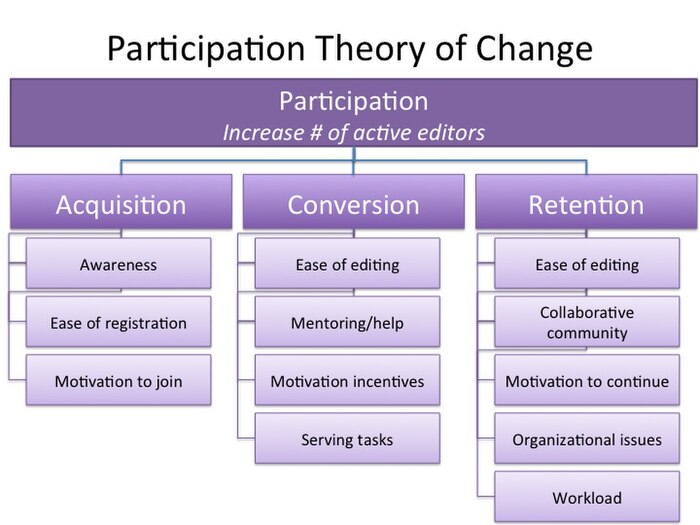Learning and Evaluation/Archive/Grantmaking and Programs/Learning & Evaluation portal/Theory of Change
This page is kept for historical interest. Any policies mentioned may be obsolete. If you want to revive the topic, you can use the talk page or start a discussion on the community forum. |
The Wikimedia Foundation has a set of strategic priorities established during the strategic planning process of 2010. All the work of the Grantmaking & Programs team is set around these seven strategies and our theories for how we can effect change in these areas.

There are a set of levers which we think effect highest level change for each of these strategies, which we call Focus Areas. These focus areas comprise the different components that are most directly related to the strategic priority. For example, in order to see any change in the number of active editors (the Participation goal) there are three places which can cause change: we can acquire more new users; we can have a higher conversion rate of new users to active editors; we can do a better job of retaining our current editor base.
Within each of these focus areas there may exist a group of levers for change. Levers are those points which activities are directly attempting to change. For example, in order to effect change within the acquiring of new users, there is either an increase in awareness, a facilitation of becoming a new user, or a stronger motivation to join. Initiatives/activities are structured along this front.
Each grant or spending channel within a large endowment of finances (e.g., FDC) should be targeted at effecting change within one or more of these focus areas and/or levers. So, within each focus area or lever of change, there is a portfolio of Grantee Projects that are working in this field. For example, within "Awareness," there could be a variety of Grantee Projects which have specific communications components meant to raise awareness.
Goals
[edit]The goals of incorporating the Theory of Change work into the our work in grant and program evaluation are:
- Common articulation of our goals and priorities
- Consistency in measuring our movement towards results
- Forced articulation of activities and spending flows with strategic goals
Definitions
[edit]| Hierarchy | Example |
|---|---|
| STRATEGIC GOAL Highest level impact goals; the point of all the work we're planning programs behind |
Increase PARTICIPATION of editors Measured in terms of active editors |
| FOCUS AREA The components which will be the major levers of change in the strategic goals. |
Acquisition of new users Bringing new users into the mix will provide a bigger base from which to create active editors. |
| LEVERS FOR CHANGE A component of an initiative that levers the achieving of the desired outcomes. |
Awareness of the possibility of editing Making sure people know that they CAN edit and/or inviting them to do so. |
| GRANTEE PROJECTS A set of money that is given to an entity of some size through some process (e.g., FDC, Grants Program, Participation grants) which is focused on creating impact towards a given strategic goal through influencing a particular initiative of the chain. |
Sample grants:
|
Detail
[edit]The full development of the focus areas and levers behind each strategic goal is our movement's Theory of Change: our hypothesis of what things we can do to move the needle in our strategic impact goals.
Built out fully, we have a suit of hypotheses. Below is an example of participation:

<insert tree graphs upon development>
Notes
[edit]A few notes regarding Infrastructure & Innovation:
- "Infrastructure" and "Innovation" do not have targets set behind them, but they are priorities because they are necessary to achieve the strategic goals
- Infrastructure and Innovation should exist only as to the extent they are enabling progress towards the other targets
- Innovative programs and ideas should fall under the five strategic goals, whereas the creation of innovative environments (e.g., wmflabs) falls directly into the innovation bucket
